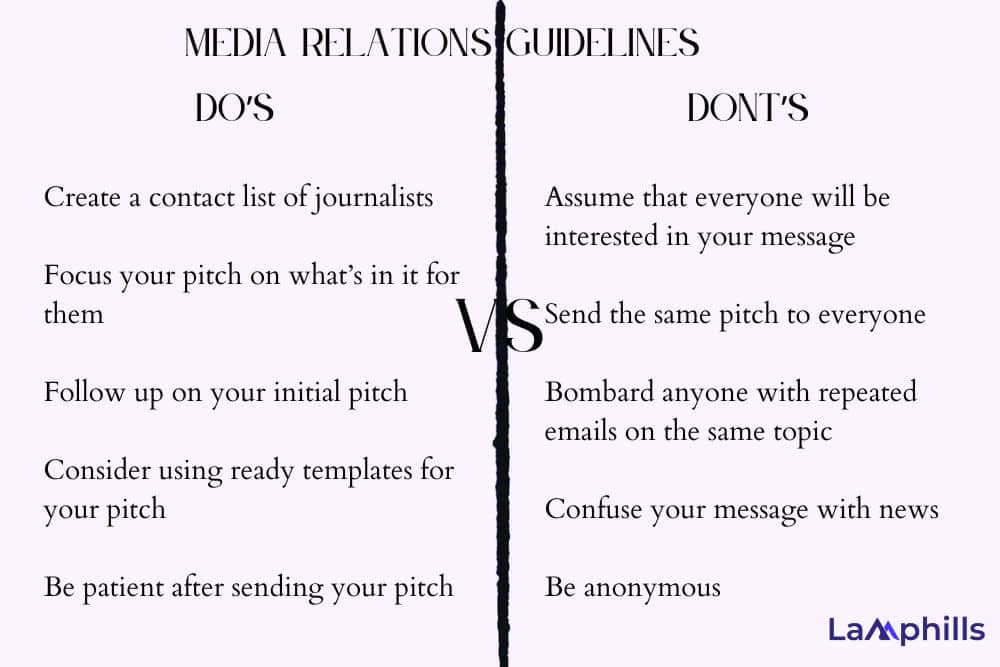How do you do PR like a pro? I mean, sure, you already know that, for your business to be successful, you need to implement at least a measure of public relations. Your communication lines are very important, and PR is the one way to bridge that gap between your business and your stakeholders.
But the question is, how do you do it effectively? Or, more importantly, how do you start?
Key Points
- Public relations (PR) is the practice of employing strategic communication to nurture a favorable public image and reputation for a brand or business.
- PR strategies are the collection of methods an organization uses to help it move from its current situation to its end goal.
- They are similar to marketing strategies because the primary goal is to spread brand awareness.
- PR strategies evaluate everything surrounding the crisis management process and help campaigns run smoother.
- Having a PR strategy provides a goal, helps you stay on track to achieve it, and ensures you know how to achieve it.
- A PR strategy will help you establish the kind of content you’ll be releasing and what media outlets will be best for spreading that content.
- A good PR strategy can help your company increase its reputation if you overcome a negative situation.
What is PR?
Public relations is the process of establishing strategic communication relationships across different media channels to promote the positive perception of your company with the relevant audiences and get additional coverage from those channels.
An established PR strategy defines every way in which a company positions itself on the global stage and communicates with all the stakeholders. These are your current and prospective customers, journalists, influencers, and anyone else who’s important to your organization. These help a company organize its public relations efforts to attract its target audience and identify ways to reach its goals during the planning stage. They’re similar to marketing strategies because the primary goal is to spread brand awareness.
Businesses often rely on outlets, such as media sources, blogs, social media or podcasts, to help them deliver messages for these strategies to a wider audience. PR professionals group these into three categories, which are:
- Owned media: This includes any outlets a company owns and operates, such as a blog, social media sites, or video channels.
- Earned media: This refers to any content a third party creates about a brand or company without being paid to do so, such as online reviews, social media posts, or word-of-mouth recommendations
- Paid media: This is any type of media a company pays for to increase its reach or exposure, such as advertisements, sponsored posts, or influencer content.
Public relations strategies also can be useful in crisis management situations because they allow organizations to respond to a negative situation and try to develop a possible outcome from it. A good strategy can help companies increase their reputation if they overcome a negative situation.
Elements of PR
Public relations teams serve many different purposes and there are various types of PR activities, each addressing its own specific goals. These are the checkpoints for your public relations roadmap, the most important elements of the basic PR plan you need to keep in mind while you’re trying to figure out how to do digital PR.
Media Relations
Chances are, this is exactly what you’re thinking about when hearing the term “public relations”. And yet, media relations management is just one of the main stepping stones on your way toward a proper PR strategy.
Here, your main goal is to build positive relations with bloggers, journalists, and influencers to get yourself media coverage for free (or close enough to it). It’s always good to have someone who speaks to large audiences on your behalf, and that’s exactly what media relations are all about.
In the digital era, establishing and maintaining media relations for PR purposes mainly involves writing press releases and other communications, pitching the media, organizing and participating in different interviews, attending special events, etc.

Crisis Management
Life happens, and that means unforeseen problems will show up in your office one day. When a crisis hits and things are moving at the speed of the internet, managing and, if needed, correcting the impressions that are created is hard.
That’s when you need a good PR specialist right there in the eye of the storm ready to back your business up with some bulletproof crisis management techniques, contacts to help get your message out in a hurry, and the ability to steer the conversation in the direction you want.
While there’s no way to be prepared for everything that gets thrown at you, the point is that your PR team is appointed as the go-to leaders in dealing with managing a crisis. When the problem hits and your reputation is on the line, there’s no time for meetings to decide who’s going to be in charge of your response — your PR should be ready to go to work in difficult circumstances at a moment’s notice.
Marketing & Communications
It’s pretty easy to forget about other important forms of communication while you’re searching for the most effective ways to do digital PR, like traditional marketing. Chances are, your business is already engaged in numerous marketing campaigns, so it’s your job to make sure those are well-managed as well.
When talking about public relations, a particularly essential aspect of marketing is social media. In a way, this is the easiest way for you to talk directly to all the stakeholders. So make sure to apply each of the basic PR plan principles discussed above to your SM strategy as well. Reply to comments and reviews (especially the negative ones), engage in online social movements and challenges, and collaborate with other brands from your area to improve community relations.
Also, don’t be afraid to try new things!
Every touchpoint where your brand gets a chance for exposure is another opportunity to shape opinions on what you’re all about. But most importantly, make sure your marketing and PR teams are on the same page. Pulling in opposite directions will get you nowhere.
Employee Relations
When you’re learning how to do digital PR, it’s easy to fall into the novice error and focus on the clients and the clients alone. In reality, public relations are much more complicated than that. For starters, you need to make sure that your PR plan never omits your own employees, both current and potential ones.
Think of it as internal PR.
First of all, your very own staff might be the strongest team of brand ambassadors you’ll ever need. At the same time, an unhappy employee is very likely to spread the harshest criticism. That’s why companies must invest in employer branding and internal PR & communications to ensure your team members feel appreciated, heard, and respected.
Community Management
Another important audience to keep in mind to help you do PR like a pro is your local community. After all, if you own an offline business, you’d most probably like to have a community spirit around it. That’s exactly what this type of PR is all about.
With community management, you ensure to communicate where your business stands on some of the crucial local issues, how it is perceived by the neighbors, and whether it makes a social commitment or not. In the long run, investing in positive community relations can provide you with new loyal brand ambassadors, a strong boost in ethical reputation for your company, more recruits in the future, and more.
Here, it’s not enough to say what your company’s behind – you need to really show it. Make sure you participate in local events sharing your expertise and time or at least donating some profits towards a worthy cause.
Highlight your good deeds online (having ongoing relations with the media from the previous point wouldn’t hurt here as well). Organize community events, and don’t be afraid to stand up for your ideas.
How To Do PR Like A Pro
In today’s competitive marketing landscape, having a comprehensive PR strategy is essential for establishing a positive company image, connecting with your target audience, and standing out in the market.
Follow these 13 effective PR strategies to elevate your brand’s reputation, build trust, and achieve long-term success:
Best PR Strategies
Common PR Campaign Objectives
Public relations is a powerful way to connect with your audience and creating the ideal campaign and implementing it properly, has never been more important.
The goal of a public relations campaign is to create a media narrative and control the spread of information about your business to attract customers. It can also be used as a tactic to generate awareness about a specific event or business venture. Most times, marketing and advertising campaigns are focused on driving sales, whereas public relations teams usually have set different PR KPIs:
- Attract media attention
- Generate awareness
- Inform the public about the latest company news
- Enhance your brand reputation
- Build stakeholder relations
Many PR experts choose to use the SMART method as a template when coming up with the goals for their PR campaign:
- Specific: What is the desired outcome?
- Measurable: How will success be measured?
- Achievable: How will the campaign achieve its goals considering outside influences?
- Realistic: Is your campaign goal realistic for the bandwidth of your campaign?
- Time-based: How long do you have to meet these goals?
Importance of PR Strategies

#1. Cement Trust in Your Brand
Your strategy will dictate how your brand approaches public debates and discussions trending within your industry.
Thought leadership is an excellent example of this, as a name and a face get attached to your brand, making the brand more human. You will gain the trust of your target audience, who will start seeing the potential of your work and values.
The more you speak up, leaning on your expertise and industry knowledge, the more likely it is to build credibility and authority within your industry.
#2. Generate Leads and Sales
Generating income is typically a focus of the marketing team. However, launching a PR campaign will inevitably contribute to increased interest in your brand. Ideally, a PR campaign will generate more publicity, sales, or leads.
#3. Boost Brand Awareness
This is one of the most important aspects of a PR strategy. Brand awareness emerges (positive or negative) as the public starts to recognize and learn about your brand, its values, and how the organization contributes to innovation within its industry.
#4. Crisis Management
A solid PR strategy foresees potential dangers to your image. Adverse events can always happen. It’s wise to be prepared to tackle those situations, which is exactly what a PR strategy can help with. Preparing for such an eventuality and creating effective statements and messaging to combat this is an essential practice.
While it is not possible to eliminate the possibility of negative PR, it is possible to prepare for counter-action should it occur.
#5. Media Relations
Launching a PR campaign means engaging with journalists and media outlets. This way, it is more appealing to the outlets that matter the most, and it increases your chances of forming a long-term relationship with that journalist that will benefit both of you in the future.
#6. Attract Investors
Having a thought-out PR strategy will ensure that your brand gets the timing right to get the most attention paid to what you want to share. Whether it’s a milestone, a successful funding round, a breakthrough, an innovation, an idea, or just a story of your brand, the more attention and better timing you have, the more investors will likely be attracted to your brand.
This can secure the trust of people who see the potential of your product or service.
#7. Grab the Attention of the Experts
Industry experts will be watching your successes and mistakes. The strategy you use can work in your favor by ensuring that the experts become advocates, especially those who are attracted to your business and who resonate with your values, beliefs, and ideas.
This can prove invaluable but requires a PR strategy that provides the best timing and positioning.
#8. Measure Your Success
You will need specific measurements and metrics in place throughout your campaign to know how well you’re doing and to get an overall measure of the success of your campaign.
Therefore, a PR strategy is necessary to establish this criterion and have a clear and concise overview of your campaign’s main objectives and secondary goals and aims. Often, it is important to use media monitoring tools to keep track of statistics relating to your online presence, activity, and web traffic from target audiences.
Proactive vs Reactive PR
Public relations is a steady mix of being proactive while also being reactive.
The proactive elements refer to staying on top of trends, anticipating questions from the media, and proactively seeking opportunities for clients that put them in a good light. These include writing press releases, pitching to media outlets, or securing coverage in a trade publication. Proactive PR helps you build valuable relationships with the media and build on your brand’s image.
Reactive PR is also necessary to respond to external events, such as the news, a trending topic, or a crisis. These events provide the opportunity to be seen as relevant and knowledgeable. They can help you identify opportunities to insert your brand into the conversation and build on approaches for future strategies. You can then get the most out of your efforts by combining both.
For example, proactive efforts can get your ideas and thought leadership content published. You can leverage this to solidify your position in the market.
What LampHills Will Do For You
While all public relations efforts are dedicated to creating and supporting the positive image of your company, there are many additional objectives you can pursue with a well-developed PR strategy.
Among all the benefits a good PR plan can bring to your business, there are certain key functions of public relations you need to be aware of. In particular, a strong public relations strategy should help you to:
- Learn and react to a particular audience’s opinion about your brand
- Actively implement strategies that improve your brand image
- Seek and maintain positive relationships with investors, journalists, clients, etc.
- Manage your online presence and the appearance of your business
- Promote your company across various media channels
- Mitigate the impact of a crisis on your brand’s reputation
Founded on the principles of transparency, creativity, and strategic insight, LampHills is your go-to if you’re seeking to enhance your public image and media relations. Armed with a team of seasoned experts, they are committed to guiding you through every step of your PR journey. They will ensure that your message not only reaches but also positively impacts your target audience.
LampHills reshapes reputations and builds lasting legacies. And with a blend of strategic expertise and creativity, they create compelling narratives that elevate your brand and leave a lasting impact. This PR agency prides itself on its unwavering commitment to delivering exceptional results while ensuring a collaborative environment that allows ideas to flourish and your reputation and legacy to thrive. We are just a click away.
Recommended Articles
- 11+ Public Relations Examples To Inspire Your Next Campaign
- 13 EMOTIONAL APPEAL ADVERTISING EXAMPLES THAT YOU CAN COPY
- Top 12 Digital PR Agencies Worldwide + Free Strategies
- EMOTIONAL APPEAL: How To Utilize The Power of Emotional Appeal Effectively
- EARNED MEDIA: Definition, Examples, and Best Practices
- Best 2024 PR Campaigns & Practical Examples (Detailed Guide)






